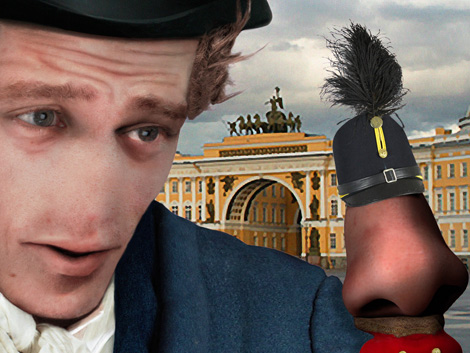Nikolai Gogol’s “The Nose” is an intriguing story about a man who loses his nose and struggles to adjust without it. Although I found the plotline quite strange, I was not prompted to question why I was reading the story. Instead, I was amused by Gogol’s use of a metaphor that seems funny on the surface, but carries the gravity of our society’s truth underneath.
The story begins with Ivan Jakovlevitch, a barber in St. Petersburg. In the very first line, Gogol hints at his habit of leaving an air of mystery in writing. He starts off with: “On the 25th March, 18—,” and continues with the details of the “strange occurrence”. In doing so, he leaves the exposition incomplete and the reader worried about the possible scope of events. (The puzzled and worried reaction is anticipated, especially after reading Kafka’s “Metamorphosis”.)

“Confused Blue Smiley.” ClipartOf. N.p., n.d. Web. 08 Oct. 2013. <http://free.clipartof.com/details/81-Confused-Blue-Smiley-Free-3D-Vector-Clipart-Illustration>.
Furthermore, Gogol, like Kafka, managed to evoke a discomforting feeling through the use of imagery. When Ivan found a nose inside the loaf of bread, I felt like a clown sprung out of a jack-in-the-box toy. Conjuring the image of a nose embedded in a loaf of bread was indeed a bad decision. The terrifying image prompts an involuntary shudder. Nonetheless, this image is not nearly as creepy as of a man who turns into a cockroach.

“Jack-in-the-box.” Wikipedia. Wikimedia Foundation, 09 Feb. 2013. Web. 08 Oct. 2013. <http://en.wikipedia.org/wiki/Jack-in-the-box>.
I found it quite interesting how my perception of the story changed from the beginning to the end. Initially, I thought that Gogol wrote a fantastical story, devoid of purpose and meaning. In fact, I found the concept of a man losing and retrieving his nose farfetched and unrealistic. It was only when I observed Major Kovaloff’s character that I realized the essence of the nose. Kovaloff’s insistence to be called a “Major,” combined with his redundant claims of knowing many powerful women, are key to understanding his shallow character. In the literal sense of the text, Kovaloff is so concerned about his false ego and others’ perception of him that he completely overlooks the fact that he is missing an organ. Although I sympathized with him, I felt that he was being very nonchalant about the real problem. After all, he had been living without a nose for days.
After reading the story, I thought that the author purposely left some questions unanswered. First, how can a nose disguise as a state-councilor? In my mind, I had a vague picture of a nose wearing a long, dark overcoat with black glasses like a detective.

“Good Book to Read: “The Nose” by Nikolai Gogol.” Rev. of “The Nose” Web log post. Splendour Eye. Blogger, 13 Jan. 2013. Web. 8 Oct. 2013. <http://splendoureye.blogspot.com/2013/01/good-book-to-read-nose-by-nikolai-gogol.html#.UlS9KFOVXaY>.
The state-councilor almost reminded me of Sherlock Holmes if it wasn’t for one discrepancy—he was a nose, for crying out loud! Given that he is an organ, I wonder if he has his own organs. Did the nose have eyes, ears, and a nose? Another question that lurks around is—Why did the nose go unnoticed by the rest of the people in St. Petersburg? Of all the people, why, or rather, how did Major Kovaloff spot the nose?
Despite these uncertainties about the technicalities, I was able to realize the underlying ideas and their significance. The nose was a symbol of pretentious pride in society. Gogol’s attempt to satirize society’s tendencies of organizing people in ranks was effective. He conveyed the deeper meaning behind his seemingly funny story through an indirect metaphor. However, I don’t see why Gogol resolved the problem in the story if his intention was to make a social commentary about ranks and prestige. It is highly unlikely that the protagonist learned his lesson after the tragedy, so why would Gogol go out of the scope of the story to resolve the problem and contradict the very arguments he raised?
More importantly, why did Gogol ask the questions that are likely to be going through the reader’s mind? Was he expressing the same uncertainty about the story and society that I was? Was he trying to build a connection with the reader in general? Or was he using rhetoric to reinstate his arguments? If the answer to any of the questions were “yes,” then the anticipated follow-up question would be, “Why?”
Works Cited:
“Confused Blue Smiley.” ClipartOf. N.p., n.d. Web. 08 Oct. 2013. <http://free.clipartof.com/details/81-Confused-Blue-Smiley-Free-3D-Vector-Clipart-Illustration>.
“Jack-in-the-box.” Wikipedia. Wikimedia Foundation, 09 Feb. 2013. Web. 08 Oct. 2013. <http://en.wikipedia.org/wiki/Jack-in-the-box>.
“Good Book to Read: “The Nose” by Nikolai Gogol.” Rev. of “The Nose” Web log post. Splendour Eye. Blogger, 13 Jan. 2013. Web. 8 Oct. 2013. <http://splendoureye.blogspot.com/2013/01/good-book-to-read-nose-by-nikolai-gogol.html#.UlS9KFOVXaY>.


 int.
int.























